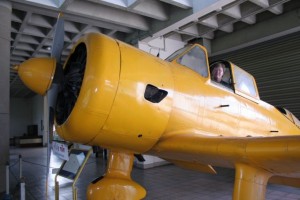 I have a special affection for this aircraft. I really don’t know why. It was the standard Japanese trainer in the time just around WWII. The last one lives here at the Royal Thai Air Force Museum, not too far from my home.
I have a special affection for this aircraft. I really don’t know why. It was the standard Japanese trainer in the time just around WWII. The last one lives here at the Royal Thai Air Force Museum, not too far from my home.
The Ki-36 (armed) and the Ki-55 (trainer) aircraft was designed in 1937 by a tream under chief engineer Endo Ryokichi, The final aircraft was approved by the Imperial Japanese Army Air Force in 1938. Exstensive flight-tests were conducted and in September 1938 two additional prototypes were build, bringing the total up to 4.
The aircraft had good forward visibility due to the 13 degree sweep of its wings. The engine was a 450 h.p. Hitachi Ha-13 with a two-blade variable pitch propeller. Armament consisted of one forward firing 7.7mm Type 89 machine gun, and one flexible drum-fed Type 89 machine gun for the observer. The aircraft could carry five 12.5 kg bombs, four 15 kg bombs, three 50kg bombs under each wing.
The aircraft had side and floor windows and a type 96 fixed camera with electrical heater could be installed.
The aircraft was used in Manchuria and over China in the beginning of the war, but it’s slow speed made it obsolete as a fighting machine early on, and it was converted into a trainer (the Ki-55). The trainer had dual-pedal, extra instruments and dual-stick installed in the read, and the rear machine gun was removed.
A total of 861 were produced.
Specifications
Wing span: 11.8 m
Length: 8 m
Height: 3.64 m
Wing area: 20 sq.m
Weight empty: 1247 kg
Weight fuelled: 1783 kg
Max speed: 348 km/h
Cruising speed: 236 km/h
Landing speed: 100 km/h
Range: 1235 km
Landing Distance: 291 m
Takeoff distance: 234 m





 29/12/2009
29/12/2009
Leave a reply